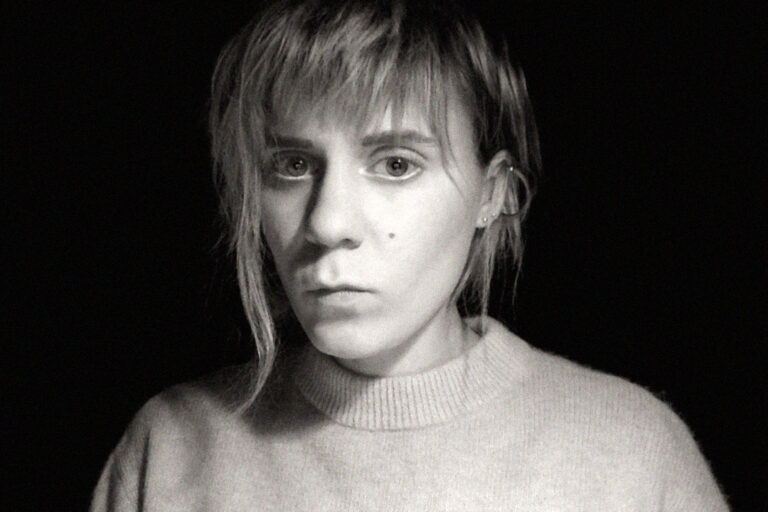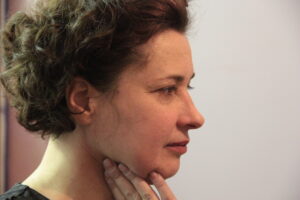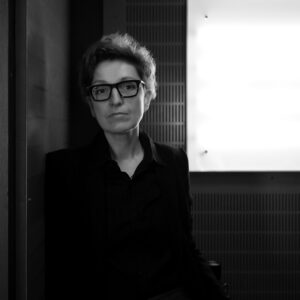Agata Cieślak

– born in 1990. She is an artist, writer and occasionally curator. She graduated from the Dutch Art Institute in Arnhem (MA Art Praxis) and later studied philosophy at the Graduate School of Social Research (PAN) in Warsaw. Since 2022 she has been a doctoral student in the philosophy department (majoring in Artistic Research) at the Mozarteum University of Salzburg. Working with different means of expression, drawing on curatorial strategies and institutional tactics in her practice, she questions structures defined in the context of contemporary art, while searching for the meaning of art and testing the limits of its causality. She is the curator and producer of the first edition of the project secondaryarchive.org . She is assisted in her search for the limits of secular morality by Hegelian metaphysics, Lacanian psychoanalysis, Marxist critique of art as an ontological and financial category and contemporary theories of comedy. Her recent work focuses on the problem of classism in art and the investigation of the mechanisms of control and sovereignty of contemporary art. Frequent collaborator. Despite her many doubts, she still believes in the essence of art.
My artistic practice begins with writing. I think that is why my work is sometimes misinterpreted and referred to as curatorial. I could never understand where this misunderstanding comes from. Perhaps it has something to do with the principle, increasingly present in contemporary art, that everyone does everything because otherwise they are unable to resist its ruthless economy. Or perhaps it stems from the fact that the profession of an artist is still not identified with agency, and I have always tried to take matters into my own hands. Or in other words, because my art practice is critical of contemporary art, it is difficult to define and position it properly.1 Or maybe it comes from the simple fact that my artistic practice is primarily writing.
I write. I write a lot. I write every day. I write from art and never about art. The act of writing is an action, which is precisely an artistic practice2. I do not write with the intention of writing, just as most artists do not create art with the intention of making a particular object. The practice of writing is material, because art created in this way is constructed from the matter of writing itself3. At the same time, my writing is not material and can be translated into various art forms in the further process of making art4. I trust that an exhibition or a performance are already appropriate modes of expression in themselves, and I always try to find ways for my writing practice to exist in these contexts as well.
It is no exaggeration to say that we are in the midst of massive political change and accompanying transformations in theories of the subject. The growing influence of capitalism and the ideologies developing in this context on social experiences and structures is colliding with an iceberg of reactionary turns. An iceberg that refuses to melt. Instead, another ice is melting, the consequences of which we have a chance to observe more and more closely in our everyday life. In this context, the role of contemporary art cannot be disregarded. Contemporary art is political in that all cultural production strives to be a future-oriented operation – organisational and persuasive, imaginative and administrative, representational and demonstrational. It seeks to sway, to mobilize, to win assent, and to establish itself as legitimate, valid, and true.
Contemporary art is about looking for alternatives, going beyond categories, stereotypes, institutions, masters and established paths of power. Today, art seems to be so committed to a critical stance that its actual, physical characteristics – its location in the context of financial systems, structure, and dependency – are taken for granted. In a sense, art appears as an innocent, peripheral, beleaguered kind of space. A bit like a chicken house made by foxes. It is worth remembering, however, that in spite of art’s loud declarations to reflect, double, problematize, and/or critique modernity, it rarely acknowledges the act of coproducing reality. Saddeningly often, contemporary art helps to organize, institutionalize and legitimize the geopolitical future5. The common reduction of art to a purely aesthetic dimension, and the popular idea that contemporary art is somehow exempt from historical evaluation, places it on the periphery and is the greatest barrier to its critical evaluation. The increasingly stronger position of the discourse of socially and politically engaged art, in which the causative power of contemporary art institutions is emphasized, is conducive to the common belief that art is an autonomous wanderlust, when in fact it requires profound, systemic changes.
The objective of my artistic practice is therefore to draw the image of what contemporary art actually is, but also a constant search for the meaning of art in a future context6. This is not to castigate art and push it into a utilitarian framework, but to recognize it as a universal discipline of knowledge production, and as a tool that allows us to experience reality on a manageable scale. Starting from this line of inquiry, my current artistic strategy expands it to include organizational experimentation, political and aesthetic issues using the central tools of comedy and pleasure7. Thus, I treat art as a kind of politics of healing and happiness that dispels the dour myth that changing the world is just another form of tedious work and and how politics can feel good and how what feels good always has a complex politics of its own8 . In short, all my criticism and resentment of existing art structures is not about is not to depict the power of art, but to generate more of it – not only by defining the problems it faces but by strengthening its institutional position. On the other hand, constantly questioning the moral economy of art is, in my opinion, the only way to reinvent the way authority is granted within it.
Text was written in collaboration with Agnieszka Sosnowska (2021).
1Image: Agata Cieślak, Anywhere or Not at All, exhibition, Pracownia Portretu, Łódź, 2020, photo Maciej Łuczak, see: pracowniaportretu.com/wystawy/50gdzie/gdzie.html. Courtesy of the artist and Pracownia Portretu.2Roland Barthes, The Preparation of the Novel, trans. Briggs, Kate, New York, Columbia University Press, 2010
3Image: Agata Cieślak, It reminds me of something but I can’t tell you what, installation, Yellow Brick, Athens, 2018, photo Sanne Kabalt, see: agata-cieslak.com/It-reminds-me-of-something-but-I-can-t-tell-you-what. Courtesy of the artist and Yellow Brick.
4Image: Agata Cieślak, Constructing, deconstructing and thinking of art, installation, Stroboskop, Warsaw, 2017, see: agata-cieslak.com/Constructing-Deconstructing-and-Thinking-of-Art. Courtesy of the artist and Stroboskop.
5Tirdad Zolghdar, Traction. An Applied and Polemical Attempt to Locate Contemporary Art, Berlin, Sternberg Press, 2016
6Image: Agata Cieślak, In Search for a Clean Finish, performance, Centrum w Ruchu, Warszawa, 2019, photo Natalia Szemis. Courtesy of an artist.
7Agata Cieślak, Sweet Sweat, performance, State of Concept, Athens, 2018, see: agata-cieslak.com/Sweet-Sweat
8Adrienne Maree Brown, Pleasure Activism, Edinburgh, AK Press, 2019
![]()
– urodzona w 1990. Jest artystką, pisarką, bywa także kuratorką. Ukończyła studia magisterskie na Dutch Art Institute w Arnhem (MA Art Praxis), później studiowała filozofię w Graduate School of Social Research (PAN) w Warszawie. Od 2022 roku jest doktorantką wydziału filozofii (kierunek Badania Artystyczne) na Uniwersytecie Mozarteum w Salzburgu. Pracując z różnymi środkami wypowiedzi, czerpiąc ze strategii kuratorskich i taktyk instytucjonalnych w swojej praktyce kwestionuje określone w kontekście sztuki współczesnej struktury, poszukując jednocześnie sensu sztuki i testując granice jej sprawczości. Jest kuratorką i producentką pierwszej edycji projektu secondaryarchive.org . W poszukiwaniu granic świeckiej moralności pomaga jej heglowska metafizyka, lacanowska psychoanaliza, marksistowska krytyka sztuki jako kategorii ontologicznej i finansowej oraz współczesne teorie komedii. W swoich ostatnich pracach skupia się na problemie klasowości sztuki oraz badaniu mechanizmów kontroli i suwerenności sztuki współczesnej. Często współpracuje. Mimo wielu wątpliwości wciąż wierzy w istotę sztuki.
Moja praktyka artystyczna zaczyna się od pisania. Wydaje mi się, że dlatego właśnie moje działania bywają źle interpretowane i określane mianem kuratorskich. Nigdy nie mogłam zrozumieć skąd bierze się to nieporozumienie. Być może wiąże się to z coraz częściej obecną w sztuce współczesnej zasadą, zgodnie z którą wszyscy robią wszystko, ponieważ inaczej nie są w stanie oprzeć się jej bezwzględnej ekonomii. Albo wynika z faktu, że zawód artystki ciągle nie jest utożsamiany jest ze sprawczością, a ja zawsze starałam się brać sprawy w swoje ręce. Albo inaczej – ponieważ moja praktyka artystyczna jest krytyczna wobec sztuki współczesnej, trudno jest ją określić i odpowiednio umiejscowić1. Najprawdopodobniej wynika to jednak z prostego faktu, że moją praktykę artystyczną stanowi przede wszystkim pisanie.
Piszę. Piszę dużo. Piszę codziennie. Piszę od sztuki i nigdy nie o sztuce. Akt pisania jest działaniem, czyli właśnie praktyką artystyczną2. Nie piszę z zamiarem pisania, tak samo jak większość artystów nie tworzy sztuki z zamiarem wykonania określonego przedmiotu. Praktyka pisania jest materialna, ponieważ sztuka tworzona w ten sposób jest konstruowana z materii samego pisania3. Jednocześnie moje pisanie nie jest materialne i można je przełożyć na różne formy w dalszym procesie tworzenia 4. Ufam, że wystawa lub performans same w sobie są już odpowiednimi środkami wyrazu i zawsze staram się znaleźć sposób, aby moja praktyka pisania zaistniała również w tych kontekstach.
Nie jest przesadą stwierdzenie, że znajdujemy się w samym środku masowych zmian politycznych i towarzyszącym im przemianom w teorii przedmiotu. Wzrost wpływu kapitalizmu i rozwijających się w tym kontekście ideologii na doświadczenia i struktury społeczne, zderza się z górą lodową reakcyjnych przełomów. Górą lodową, która nie chce się stopić. Topi się natomiast inny lód, czego konsekwencje mamy szanse coraz wnikliwiej obserwować w naszej codzienności. W tym kontekście nie można lekceważyć roli sztuki współczesnej. Sztuka współczesna jest polityczna w tym sensie, że każda produkcja kulturalna stara się być operacją zorientowaną na przyszłość – organizacyjną i przekonującą, pomysłową i administracyjną, reprezentacyjną i demonstracyjną. Stara się kołysać, mobilizować, zdobyć aprobatę i stać się dyscypliną prawowitą, ważną i prawdziwą.
Sztuka współczesna to szukanie alternatywnych rozwiązań, wyjścia poza kategorie, stereotypy, instytucje, mistrzów i utarte ścieżki władzy. Obecnie sztuka zdaje się być tak bardzo zaangażowana w postawę krytyczną, że jej faktyczne, fizyczne cechy – położenie w kontekście systemów finansowych, struktury i zależności – są traktowane jako coś oczywistego. W pewnym sensie sztuka jawi się jako niewinna, peryferyjna, oblężona przestrzeń. Trochę taki kurnik zrobiony przez lisy. Warto jednak przypomnieć, że mimo nieustannych deklaracji sztuki o jej wpływie na problematyzowanie i krytykę współczesności, rzadko jednak uznaje ona akt współtworzenia rzeczywistości. Zasmucająco często sztuka współczesna pomaga organizować, instytucjonalizować i legitymizować geopolityczną przyszłość5. Nagminne sprowadzanie sztuki do wymiaru czysto estetycznego oraz popularna idea, że sztuka współczesna jest w jakiś sposób wyjęta spod oceny historycznej, lokuje ją na peryferiach i jest największą barierą dla jej krytycznej oceny. Coraz silniejsza pozycja dyskursu sztuki zaangażowanej społecznie i politycznie, w którym akcentowana jest sprawczość instytucji sztuki współczesnej sprzyja powszechnemu przekonaniu, że sztuka to autonomiczny wanderlust, kiedy faktycznie wymaga dogłębnych, systemowych zmian.
Celem mojej praktyki artystycznej jest zatem nakreślenie obrazu tego, czym właściwie jest sztuka współczesna, ale także ciągłe poszukiwanie sensu sztuki w kontekście przyszłościowym6. Nie chodzi o to, by karcić sztukę i wciskać ją w ramy utylitaryzmu, ale uznać ją za powszechną dyscyplinę produkcji wiedzy, a także jako narzędzie, które pozwala na doświadczanie rzeczywistości w dającej się kontrolować skali. Wychodząc od tego kierunku dociekań, moja obecna strategia artystyczna rozszerza go o eksperymenty organizacyjne, kwestie polityczne i estetyczne z użyciem centralnych dla mnie narzędzi komedii i przyjemności7. Tym samym traktuję sztukę jako swoistą formę polityki uzdrawiania i szczęścia, która obala ponury mit, że zmienianie świata to kolejna forma męczącej pracy i że uprawianie polityki nie może być dobre, a to, co jest dobre, zawsze jest swoją własną, złożoną polityką 8. Krótko mówiąc, cała moja krytyka i niechęć do istniejących struktur sztuki nie polega na umniejszaniu sprawczości sztuki, ale na jej generowaniu – nie tylko przez określanie problemów, z którymi się mierzy ale i wzmacnianiu jej instytucjonalnej pozycji. Natomiast, ciągłe kwestionowanie moralnej ekonomii sztuki to w moim odczuciu jedyny sposób, żeby na nowo nadać tej dziedzinie autorytet.
Tekst powstał we współpracy z Agnieszką Sosnowską (2021).
1Zdjęcie: Agata Cieślak, Gdziekolwiek albo wcale, wystawa, Pracownia Portretu, Łódź, 2020, zdj. Maciej Łuczak, zob. pracowniaportretu.com/wystawy/50gdzie/gdzie.html. Dzięki uprzejmości artystki i Pracowni Portretu.2Roland Barthes, The Preparation of the Novel, trans. Briggs, Kate, New York, Columbia University Press, 2010
3Zdjęcie: Agata Cieślak, It reminds me of something but I can’t tell you what, instalacja, zdj. Sanne Kabalt, Yellow Brick, Ateny, 2018, zob. agata-cieslak.com/It-reminds-me-of-something-but-I-can-t-tell-you-what. Dzięki uprzejmości artystki i Yellow Brick.
4Zdjęcie: Agata Cieślak, Constructing deconstructing and thinking of art, instalacja wideo, Stroboskop, Warszawa, 2017, zob. agata-cieslak.com/Constructing-Deconstructing-and-Thinking-of-Art. Dzięki uprzejmości artystki i Galerii Stroboskop.
5Tirdad Zolghdar, Traction. An Applied and Polemical Attempt to Locate Contemporary Art, Berlin, Sternberg Press, 2016
6Zdjęcie: Agata Cieślak, W poszukiwaniu czystego wykończenia, performance, 2019, Centrum w Ruchu, Warszawa, zdj. Natalia Szemis. Dzięki uprzejmości artystki.
7Agata Cieślak, Sweet Sweat, performance, State of Concepts, Ateny, 2018, zob. agata-cieslak.com/Sweet-Sweat
8Adrienne Maree Brown, Pleasure Activism, Edinburgh, AK Press, 2019


